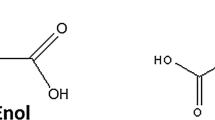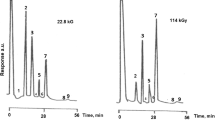Abstract
Studies in chemical evolution are intended to demonstrate how compounds of biological importance are generated from substances that could have been found in abiotic conditions on the primitive Earth or in extraterrestrial environments. In this context, the aim of the present work was to examine the behavior of dl-glyceraldehyde in both aqueous solution and solid samples under gamma irradiation. We irradiated dl-glyceraldehyde at different doses and temperatures with a gamma source; even at low doses and temperature (77 K), free radicals were detected. Among the products formed were ethylene glycol and glycolaldehyde. Some sugar-like compounds were also detected.







Similar content being viewed by others

References
Miller SL, Orgel L (1974) The origins of life on earth. Prentice-Hall Inc, Eagle Cliffs
Weber AL, Pizzarello S (2006) The peptide-catalyzed stereospecific synthesis of tetroses: a possible model for prebiotic molecule evolution. PNAS 103:12713–12717
Draganic IG, Draganic ZD, Adloff JP (1990) Radiation and radioactivity. CRC Press Inc, Boca Raton
Draganic I, Draganic Z (1998) Radiation-chemical approaches to comets and interstellar dust. J Chim Physique 85:55–61
Mosqueira FG, Albarrán G, Negrón-Mendoza A (1996) A review of conditions affecting the radiolysis due to 40K on nucleic acid bases and their derivatives adsorbed on clay minerals: implications in prebiotic chemistry. Origins Life Evol Bios 26:75–94
Negrón-Mendoza A, Albarrán G (1993) In: Chela-Flores J, Ponnamperuma C (eds) Chemical evolution: origin of life. Deepak Publishing, Jalandhar, pp 147–235
Cataldo F, Ursini O, Angelini G, Iglesias-Groth S, Manchado A (2011) Radiolysis and radioracemization of 20 amino acids from the beginning of the solar system. Rend Fis Acc Lincei 22:81–94
Draganic IG, Draganic ZD (1971) The radiation chemistry of water. Academic Press, New York
Kochetkov NK, Kudrjashov LI, Chlenov MA (1979) Radiation chemistry of carbohydrates. Elsevier Ltd, Amsterdam
Nair V, O’Neil CL, Wang PG (2008) Malonaldehyde, encyclopedia of reagents for organic synthesis. Wiley, New York
Kwon T, Watts B (1963) Determination of malonaldehyde by ultraviolet spectrophotometry. J Food Sci 28:627–630
Steenken S, Schulte-Frohlinde D (1973) Fragmentation of radicals derived from glycolaldehyde and glyceraldehyde in aqueous solution. an EPR study. Tetrahedron Lett 9:653–654
Negron-Mendoza A, Ramos-Bernal S (2004) In: Seckbach J (ed) Cellular origin, life in extreme habitats and astrobiology. Springer, Berlin, pp 181–194
Jørgensen JK, Favre C, Bisschop SE, Bourke TL, van Dishoeck EF, Schmalzl M (2012) Detection of the simplest sugar, glycoladehyde, in a solar-type protostar with ALMA. Ap JL 757:L4
Meinert C, Myrgorodska I, De Marcellus P, Buhse T, Nahon L, Hoffmann SV, Le Sergeant d’Hendecourt L, Meierhenrich UJ (2016) Ribose and related sugars from ultraviolet irradiation of interstellar ice analogs. Science 352:208–212
Scherz H (1970) Formation of deoxycompounds and malonaldehyde in irradiated aqueous solutions of carbohydrates and related compounds. Rad Res 43:12–24
Steenken S (1979) Oxidation of phenolates and phenylenediamines by 2-alkononyl radicals produced from 1, 2-dihydroxy- and 1-hydroxy-2-alkoxyalkyl radicals. Phys Chem 83:595–599
von Sonntag C (1980) In: Tipson RS, Horton D (eds) Advances in carbohydrate chemistry and biochemistry. Academic Press, NY, pp 7–77
Acknowledgments
We acknowledge the support from C001-CONACYT-ANR-188689 and DGAPA Grant IN111116. We thank Benjamin Leal, M.Sc., and Francisco Flores, Phys., for their technical assistance. Finally, we are grateful to the unknown reviewers for their valuable comments.
Author information
Authors and Affiliations
Corresponding author
Rights and permissions
About this article
Cite this article
Cruz-Castañeda, J., Aguilar-Ovando, E., Buhse, T. et al. The importance of glyceraldehyde radiolysis in chemical evolution. J Radioanal Nucl Chem 311, 1135–1141 (2017). https://doi.org/10.1007/s10967-016-5080-2
Received:
Published:
Issue Date:
DOI: https://doi.org/10.1007/s10967-016-5080-2



